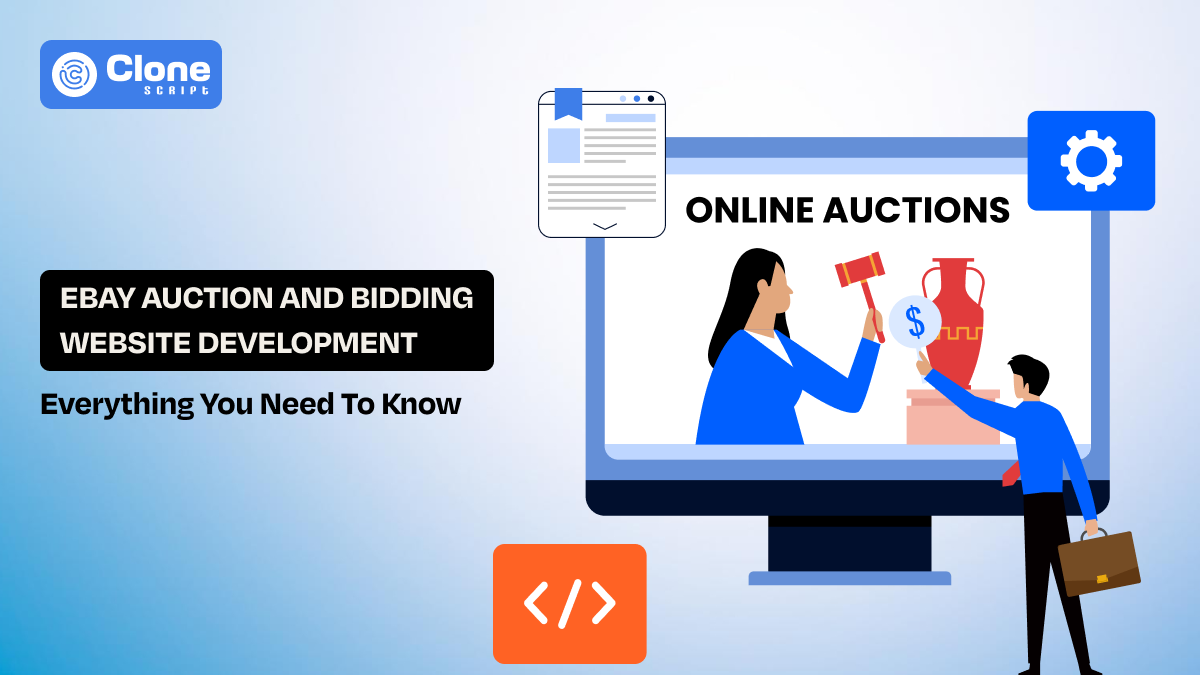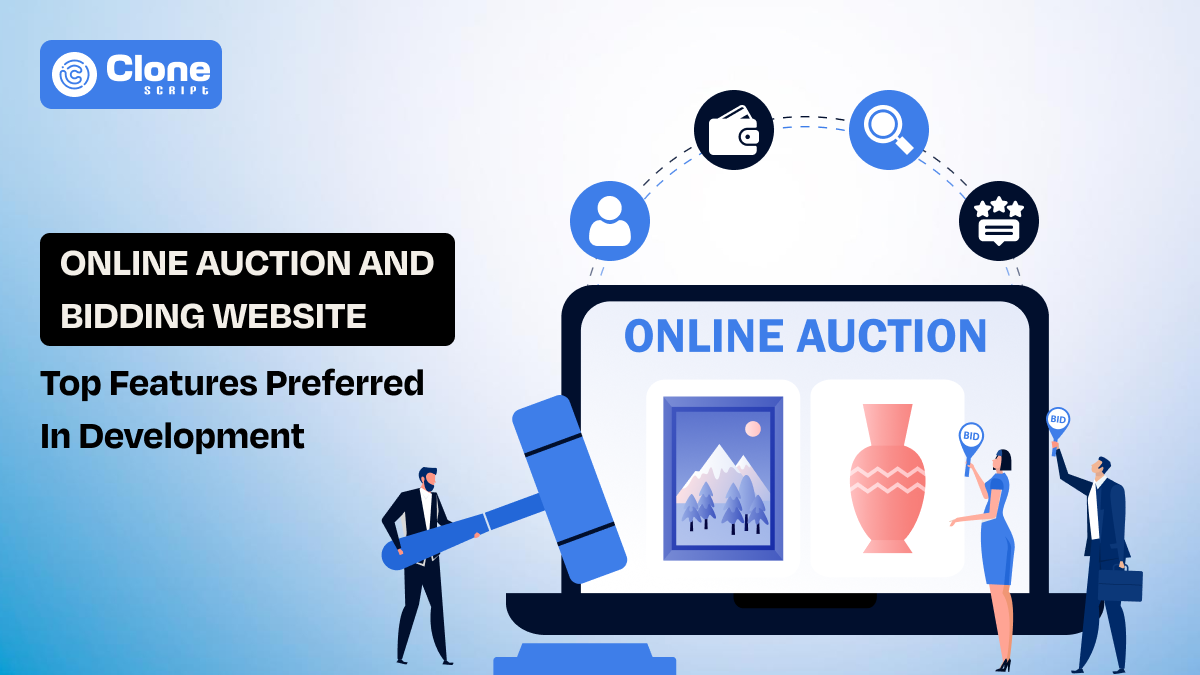How to Create an Online Auction and Bidding Website Like Ebay
As online auctions are becoming the most preferred choice of both buyers and sellers now, new brands are coming out to make a secure platform. Popular websites like eBay and Sotheby’s manage entire bidding virtually. But the question is, “Can I make the site like eBay?”
The answer is yes. By following this guide, you can get an idea of how to make an auction website along with costs associated, marketing and and post-launch activities.
Why Build an Online Auction and Bidding Website Like eBay?
Every successful online business is built on human psychology, and auctions are no different. The desire to win, to outbid, to secure something rare, that’s what keeps users coming back.
An auction website model does more than sell products; it creates an experience. Unlike static e-commerce platforms, auctions make every interaction dynamic and unpredictable.
-
Sellers enjoy higher engagement and better prices, while buyers enjoy the adrenaline of timed competition.
Moreover, building an auction platform today allows businesses to explore multiple revenue streams — from listing fees to premium seller accounts and advertising. Whether it’s rare art, real estate, electronics, or collectibles, online bidding has room for every niche.
In short, an auction platform like eBay doesn’t just host products; it builds communities around transactions.
How an Online Auction Website Works?
At its core, an online auction website works as a digital meeting ground, a marketplace where transparency meets technology.
Here’s how it operates:
-
Sellers list products with details like images, descriptions, and starting prices.
-
Registered buyers place bids until the timer runs out.
-
The system tracks bids in real time and notifies users of changes.
-
The highest bidder wins, and payment is securely processed.
-
Post-sale logistics, like shipping and reviews, follow.
Behind this simple flow lies powerful functionality: real-time data updates, secure user authentication, and scalable databases. These manage every bid, every click, and every transaction that happens smoothly and transparently.
5 Core Features Every Bidding Website Like eBay Should Have
To truly compete in this market, you need more than functionality — you need trust, reliability, and usability. Let’s explore the essential functionality for an online auction platform.
-
User Registration and Profile Management
Your users should feel welcomed, not overwhelmed. A simple, secure registration process — whether through email or social media — sets the tone. Once inside, personalized dashboards help them track bids, manage listings, and view past purchases without friction.
Add layers of credibility like verified badges or two-factor authentication. When users trust the process, they’re more likely to return, bid confidently, and recommend your platform to others.
-
Product Listings and Bidding System
An auction’s success depends on its listings. The more authentic and detailed they are, the stronger your users’ confidence. Each product page should tell a story — clear photos, honest descriptions, and fair starting bids.
Real-time bidding, countdown timers, and auto-bid features keep the thrill alive. Let buyers feel the pressure of those final seconds. That’s where engagement peaks, and your platform truly shines.
-
Notifications and Real-Time Updates
Bidding is emotional. People don’t want to miss out because they weren’t notified. That’s why timely alerts matter — a text, an email, or a gentle app ping can make all the difference.
Allow users to control what kind of notifications they receive so it feels personal, not pushy. When done right, these small reminders create anticipation and keep your users glued to the action until the final second.
-
Reviews, Ratings, and Dispute Handling
Trust doesn’t come from technology — it comes from people. Reviews and ratings are social proof that your platform is safe and fair.
Encourage verified buyers to share honest feedback and allow sellers to respond. In case something goes wrong, a clear dispute system shows that you care about resolution, not just revenue. It’s these details that make users feel protected and respected.
5. Analytics and Personalization (Bonus Feature)
Behind every great auction site is data quietly doing its job. Analytics help you understand what users love and what they skip.
Use this insight to personalize recommendations, highlight trending items, and make every visit feel tailor-made. When users see products that match their interests, engagement naturally grows. It’s not about algorithms. It’s about understanding human behavior and using it to create better, more intuitive experiences.
Step-by-Step Guide to Create an Online Auction Website (Like eBay)
Building a successful online auction platform is beyond writing code and shaping an experience. Here’s a guide on how to bring your idea to reality
Step 1: Define Your Business Model
Before writing a single line of code, define what kind of marketplace you want to build.
Ask the question: Will it be open like eBay, or niche-focused like StockX or Catawiki?
-
Decide how you’ll earn revenue — through listing fees, commissions, or premium memberships. Map out your audience, product categories, and seller policies.
The clearer your business model, the smoother the next stages become. Remember, successful auction websites balance business goals with user satisfaction.
Step 2: Design for User Experience (UX) and Simplicity
Design is where your platform’s personality lives. Look at how Etsy and eBay make navigation intuitive: clean menus, product-centered layouts, and fast loading times.
Follow these online auction website design best practices: use large product photos, bold CTAs, visible timers, and balanced color schemes. Keep it simple yet emotionally engaging. Every scroll should feel natural, and every click should lead somewhere purposeful. A user-friendly interface builds trust before the first bid is ever placed.
Step 3: Choose the Right Technology Stack
Your platform’s performance depends on the technology that powers it. Companies like eBay rely on a combination of robust frameworks and scalable databases, typically Node.js, React, Laravel, or Django.
If you’re a startup, consider cost-efficient solutions like WordPress with auction plugins to test your concept quickly.
As your platform grows, you can always migrate to a more custom setup. The key is flexibility. Pick a stack that can evolve with your vision.
Step 4: Build the Platform (From Scratch or Template-Based)
Now comes the exciting part — development. You can either build your auction platform from scratch for complete customization or use a ready-made template like BidZone HTML Template for a faster, more affordable launch.
Templates work best for businesses that want a functional starting point with a clean design and mobile responsiveness. Custom development, on the other hand, gives you control over every element, ideal if you plan to scale or introduce unique features later.
Step 4: Integrate Payment Gateway and Transaction System
A reliable payment system is the foundation of user trust. eBay’s seamless payment experience, built around PayPal and managed payments, is a benchmark for all auction sites.
-
Offer multiple gateways like Stripe, PayPal, or Razorpay for flexibility. Include features like instant payments, transaction tracking, and refund processing.
Above all, ensure PCI-DSS compliance to protect financial data.
Transparency and speed in payments make users feel confident about transacting on your platform, and confidence keeps them coming back.
Step 5: Build the Admin Panel and Management Features
A strong admin panel is your control tower. It’s where every user, product, and transaction can be monitored effortlessly.
Take inspiration from eBay’s backend moderation system — it manages listings, verifies sellers, handles disputes, and analyzes activity in real time.
Your admin dashboard should include user analytics, financial reports, and fraud detection tools. Think of it as your operational heart — the smoother it beats, the healthier your marketplace will run.
Step 7: Optimize for Mobile and Responsiveness
In 2025, most online bids come from mobile users. That’s why your website should adapt beautifully to every screen.
Start with a responsive design. It’s affordable and flexible. Later, consider building a dedicated mobile app like eBay’s, offering push notifications, one-click bidding, and saved auctions.
Mobile-first thinking isn’t optional anymore. It’s what ensures your users stay connected, whether they’re on a train, at work, or in bed scrolling through live bids.
Step 8: Implement Security and Fraud Prevention
Security is the invisible shield that keeps your business alive. Platforms like eBay and Sotheby’s have earned user trust because they treat protection as a feature, not an afterthought.
-
Use SSL encryption, two-factor authentication, and fraud detection algorithms to safeguard users.
-
Regularly audit your code and update your payment integrations.
Let users see visible trust signals: padlocks, badges, and privacy assurances. In auctions, peace of mind is just as valuable as the winning bid.
Step 9: Estimate the Cost and Build Smart
Your budget will depend on complexity and goals. A basic MVP with standard bidding features may cost between $5,000 – $8,000, while a fully customized, enterprise-grade platform like eBay can exceed $30,000.
-
Using a high-quality template like the BidZone template helps cut development costs without sacrificing performance.
The smartest investment isn’t just money. It’s the time you spend refining your product before launch. A stable, well-tested auction platform is always more profitable in the long run.
Step 10: Test, Launch, and Scale
Before launch, test every element, from bid placement to checkout. Simulate high-traffic scenarios to ensure your servers can handle real-time bidding. Once live, focus on marketing and user onboarding.
Platforms like eBay grew by constantly listening to user feedback and improving based on data.
Do the same.
Introduce new features, scale your hosting, and polish your UX as traffic grows. Launching an auction website isn’t a one-time project. It’s an ongoing evolution.
Marketing Your Online Auction Website.
Building your auction platform is only half the story. Getting people to use it is where the real challenge begins. Marketing an online bidding website is about creating trust, sparking curiosity, and nurturing community.
-
Start by identifying your audience — are you targeting collectors, bargain hunters, or business resellers? Then, position your platform around what makes it special.
-
Use content marketing, influencer partnerships, and social proof to create awareness.
-
SEO optimization is your silent growth engine. Optimize product listings, blogs, and landing pages for auction-related search terms like “rare collectibles” or “online bidding platform for art.” Add value before you sell. That’s how you build authority.
-
Finally, engage through email campaigns and push notifications. Remind users of ending bids, upcoming auctions, and new listings. Marketing isn’t just about reach — it’s about timing, relevance, and relationships.
eBay grew rapidly by letting early users tell their success stories, and word-of-mouth remains the most authentic form of marketing.
Launch, Test, and Scale Your Auction Website.
The moment you launch your auction platform, you’re not just releasing a product — you’re introducing a digital experience that people will trust with their time and money. Before going public, run multiple QA & Testing rounds: simulate live auctions, check payment flows, and verify notification systems.
-
Once live, gather early feedback aggressively. eBay’s evolution was built on continuous user testing — listening, improving, and iterating.
-
Monitor server response times, user satisfaction scores, and transaction volumes.
-
As your platform gains traction, scalability becomes key. Move to cloud-based hosting (like AWS or Google Cloud) to handle traffic spikes during peak auctions.
-
Add caching systems for speed, and keep your code modular to support new features.
Scaling isn’t about expanding fast. It’s about growing smart. Prioritize stability, user experience, and data-driven improvement. That’s how a small idea transforms into a trusted global bidding hub.
Conclusion
The dream of building an online auction platform like eBay isn’t out of reach. It’s simply a matter of structure, patience, and the right execution. If you’re ready to start quickly without compromising on quality, explore the BidZone website template, perfect for anyone looking to launch a professional online auction website.
FAQs
-
How long does it take to build an online auction and bidding website like eBay?
Typically, a basic version can take 6–10 weeks to develop, while a fully customized, feature-rich platform may take 3–6 months, depending on your team’s resources and complexity.
-
What’s the average cost to build an online auction and bidding site?
The cost usually ranges from $5,000 to $30,000, depending on the design complexity, features, and technology used. Using templates like BidZone can reduce costs significantly.
-
Which payment gateway is best for auction websites?
Popular and reliable options include PayPal, Stripe, and Authorize.net. Choose gateways that support international transactions and offer strong fraud protection.
-
How can I make my auction platform mobile-friendly?
Start with responsive web design to ensure your site adapts to any screen. As your audience grows, consider building a dedicated mobile app for better engagement and real-time notifications.
-
How can I attract sellers and buyers to a new auction website?
Offer low listing fees, promote exclusive categories, and use targeted social media marketing. Incentivize early adopters with discounts or loyalty points to encourage participation.
 BTC - Bitcoin
BTC - Bitcoin
 USDTERC20 - USDT ERC20
USDTERC20 - USDT ERC20
 ETH - Ethereum
ETH - Ethereum
 BNB - Binance
BNB - Binance
 BCH - Bitcoin Cash
BCH - Bitcoin Cash
 DOGE - Dogecoin
DOGE - Dogecoin
 TRX - TRON
TRX - TRON
 USDTTRC20 - USD TRC20
USDTTRC20 - USD TRC20
 LTC - LiteCoin
LTC - LiteCoin







